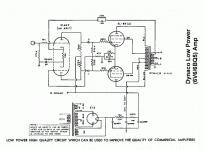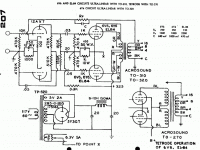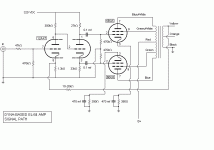Hi guys
Just wondering have you ever make this Amp....
http://www.diyparadise.com/simpleel84.html
I just wondering how it sounds...??
Just wondering have you ever make this Amp....
http://www.diyparadise.com/simpleel84.html
I just wondering how it sounds...??
Mas Penk said:Hi guys
Just wondering have you ever make this Amp....
http://www.diyparadise.com/simpleel84.html
I just wondering how it sounds...??
There is a similar design on the Triode site, but using a 6C4 fo the driver. When I built my ST35 clone I tried it for fun, but it sounded quite poor. For the couple of extra dollars to have 2 ECC99 (1 per channel) and a couple of transistors/FETS to make a CCS in the tail of the driver to make a differential stage, you'll get a much better sounding amp.
Alternatively, you could use a paraphase splitter like the Magnavox console amps. This can also sound very good, and doesn't require the CCS.
Also, the amp you linked is wired in UL, it's output impedance will be quite high which may create some frequency response errors
Why not use another ECC99 and have a gain stage into a concertina? The ECC99 is both a great gain stage - low anode impedence so you can have an unbypasased cathode resistor - and a great tube for a concertina. I don't have a circuit, but you could start with 22k anode resistor on the first valve and 22k on top and bottom of the concertina, and adjust the cathode resistor of the input tube to suit your needs. I'm about to try this very thing when I get some time. At the moment I'm using a 6EW7 - second section first, into the first section as a concertina. Sounds pretty nice, and very simple.
andyjevans said:Why not use another ECC99 and have a gain stage into a concertina?
Speaking for myself, I've never heard a concertina I liked, with a diff always sounding better and having one less stage. When I played with the paraphase it surprised me how good it could sound too, but completely different to the diff.
If i use EL84 as Driver will it sound better?
Because that site the author said that the amp will be more natural and live if we drive with EL84. It looks like he follows the Sakuma Amp which has implement "like drive like". Meaning if we like the sound of EL84 then use EL 84 to Drive EL84...
btw does anyone has schematic for Good & Simple EL84... ?
Does magnavox amp use same OP spec like i have 8K PP with UL 40%?
thanks
Because that site the author said that the amp will be more natural and live if we drive with EL84. It looks like he follows the Sakuma Amp which has implement "like drive like". Meaning if we like the sound of EL84 then use EL 84 to Drive EL84...
btw does anyone has schematic for Good & Simple EL84... ?
Does magnavox amp use same OP spec like i have 8K PP with UL 40%?
thanks
RIGHT SAID BRETT...
Hi,
Agreed...not too many people understand differential stages though.
I feel every tubelover owes it to himself to study phasesplitters and balanced circuits indepth...
Understanding AC behaviour versus DC behaviour does help alot, as does static versus dynamic behaviour....
Greetz to OZ,
Hi,
When I played with the paraphase it surprised me how good it could sound too, but completely different to the diff.
Agreed...not too many people understand differential stages though.
I feel every tubelover owes it to himself to study phasesplitters and balanced circuits indepth...
Understanding AC behaviour versus DC behaviour does help alot, as does static versus dynamic behaviour....
Greetz to OZ,
Hi,
Sorry to say so but too much salt is just that....
Cheers,
It looks like he follows the Sakuma Amp which has implement "like drive like". Meaning if we like the sound of EL84 then use EL 84 to Drive EL84...
Sorry to say so but too much salt is just that....
Cheers,
Mas Penk said:If i use EL84 as Driver will it sound better?
I like the EL84 as a driver for larger powertubes, but I seriously doubt it's going to sound any better here.
Because that site the author said that the amp will be more natural and live if we drive with EL84. It looks like he follows the Sakuma Amp which has implement "like drive like". Meaning if we like the sound of EL84 then use EL 84 to Drive EL84...
Wrong. Sakuma-san's idea in using an 845 to drive an 845 is to have a driver that is able to swing the up to 140Vpeak that an 845 needs with as low a distortion as the 845 output tube, not because of the "sound" of the tube. Similarly with the 300B=>300B, though it's less of an issue with the 300B only needing 80V or so.
In the case with the EL84, you only need about 20V to drive the grids however you run them, and an ECC99 is more than up to the task. The ECC99 also hav less than half the input capacitance so it's easier for the previous stage to drive too (vi a vis the EL84 as a driver).
btw does anyone has schematic for Good & Simple EL84... ?
Does magnavox amp use same OP spec like i have 8K PP with UL 40%? [/B]
As I mention above, an EL84 UL amp with no NFB is going to have a very high output impedance and will affect the frequency response of the speaker markedly. So you either need to go triode and live with less power, or add some feedback which will mean more gain is required in the driver.
I'm not really fond of UL, preferring pentode esp if using NFB.
The Magnavox I mentioned is pentode with NFB.
Another simple design is the Acro or Dyna designs posted below. I'd use a 6SL7 in preference to the 12AX7 though.
Attachments
Re: RIGHT SAID BRETT...
Hi Frank,
Can only saw I agree.
One pet hate of mine is the term phase-splitter, because it's not a splitter, but an inverter, and then you get all these idiotic posts from the cult of the SET types who think that it cuts the signal in half.
Cheers
Brett
fdegrove said:I feel every tubelover owes it to himself to study phasesplitters and balanced circuits indepth...
Understanding AC behaviour versus DC behaviour does help alot, as does static versus dynamic behaviour....
Hi Frank,
Can only saw I agree.
One pet hate of mine is the term phase-splitter, because it's not a splitter, but an inverter, and then you get all these idiotic posts from the cult of the SET types who think that it cuts the signal in half.
Cheers
Brett
Hi,
Join the club...
I bet you they don't have a clue how PP circuits work either, right?
Ahhhh well, they'll eventually come to their senses I suppose...
Cheers,
One pet hate of mine is the term phase-splitter, because it's not a splitter, but an inverter,
Join the club...
and then you get all these idiotic posts from the cult of the SET types who think that it cuts the signal in half.
I bet you they don't have a clue how PP circuits work either, right?
Ahhhh well, they'll eventually come to their senses I suppose...

Cheers,
hi all
the use of el84 as a driver to drive el84 output stage, was such that the distortion generated by the driver el84 will be sort of "cancelled out" by the subsequent el84 output stages, since they are 180 deg out of phase. to a certain extent, this seemed to work well and i got a very transparent natural sound. so natural i haven't heard it in other amp designs i have worked on.
note that the use of ccs is already a form of localized nfb.
with the ccs in place, the sonics is brought up another level. noise floor went down, bass performance improved!
but of course, if you can live with the reduced power, triode mode has added realism and refinement.
in case you are thinking of adding another phase splitting stage, there is no need for this as the output stage IS the phase splitting stage.
all this talk is naught. build it and listen for yourself. the sonics is between pure se and pure pp. the mids and highs can rival many se amps out there, plus the advantage of pp performance in the lows.
DonJuan
the use of el84 as a driver to drive el84 output stage, was such that the distortion generated by the driver el84 will be sort of "cancelled out" by the subsequent el84 output stages, since they are 180 deg out of phase. to a certain extent, this seemed to work well and i got a very transparent natural sound. so natural i haven't heard it in other amp designs i have worked on.
As I mention above, an EL84 UL amp with no NFB is going to have a very high output impedance and will affect the frequency response of the speaker markedly. So you either need to go triode and live with less power, or add some feedback which will mean more gain is required in the driver.
note that the use of ccs is already a form of localized nfb.
with the ccs in place, the sonics is brought up another level. noise floor went down, bass performance improved!
but of course, if you can live with the reduced power, triode mode has added realism and refinement.
in case you are thinking of adding another phase splitting stage, there is no need for this as the output stage IS the phase splitting stage.
all this talk is naught. build it and listen for yourself. the sonics is between pure se and pure pp. the mids and highs can rival many se amps out there, plus the advantage of pp performance in the lows.
DonJuan
Zero global feedback UL sounds pretty good, as a matter of fact. Yes, a bit down in the high treble, but lovely mids. I'd give it a try. Just gives you a bit more volume than triode mode with EL84s.
One question about the 'simple' dyna schematic above posted by Mr Grunty - how is the input valve (12ax7) biased? I just see a 100uF on the cathode. Am I missing something?
One question about the 'simple' dyna schematic above posted by Mr Grunty - how is the input valve (12ax7) biased? I just see a 100uF on the cathode. Am I missing something?
Hi,
Look again; I see 100R (undecoupled) + 1K (decoupled) cathode resistor for the input side, the same 1K is in commn with the other half of the 12AX7A.
Cheers,
One question about the 'simple' dyna schematic above posted by Mr Grunty - how is the input valve (12ax7) biased? I just see a 100uF on the cathode. Am I missing something?
Look again; I see 100R (undecoupled) + 1K (decoupled) cathode resistor for the input side, the same 1K is in commn with the other half of the 12AX7A.
Cheers,
DonJuan said:the use of el84 as a driver to drive el84 output stage, was such that the distortion generated by the driver el84 will be sort of "cancelled out" by the subsequent el84 output stages, since they are 180 deg out of phase. to a certain extent, this seemed to work
"To a certain extent this seemed to work" about sums it up. The distortion spectrum generated by the output tube is going to vary considerably more and over a much greater range with respect to level and frequency that the driver will, as it's (the driver) working into a relatively stable impedance. All that's going to happen is that at a certain frequency and level the distortion will cancel, and everywhere else it will vary all over the place. Not a recipe for good sonics IME.
with the ccs in place, the sonics is brought up another level. noise floor went down, bass performance improved!
but of course, if you can live with the reduced power, triode mode has added realism and refinement.
Yep.
in case you are thinking of adding another phase splitting stage, there is no need for this as the output stage IS the phase splitting stage.
Not the circuit originally posted; that's a very sloppy diff amp and will give poor performance.
the sonics is between pure se and pure pp.
Nope, it's the worst of all worlds.
the mids and highs can rival many se amps out there, plus the advantage of pp performance in the lows.
There are extremely few "pure" PP amps out there and they're better than everything else I've ever heard, everywhere; mids, highs, lows, soundstage, imaging, musicality and lack of editorialising of the performance.
Hi,
Indeed, I was...sorry.
The one you refer to has a 100R cathode R which is in common for both triodes and is decoupled with a 100µF cap.
Cheers,
I think you're referring to the other one. Andy
Indeed, I was...sorry.
The one you refer to has a 100R cathode R which is in common for both triodes and is decoupled with a 100µF cap.
Cheers,
Here is an even 'simpler' version of the same for your consideration. Can someone kindly comments on its sonic performance?andyjevans said:... the 'simple' dyna schematic above posted by Mr Grunty..
Thnx.
Attachments
The one you refer to (dynaco Low Powered) has a 100R cathode R which is in common for both triodes and is decoupled with a 100µF cap.>>
I see 100R between the cathode 1 and cathode 2, with cathode 2 taken to ground through the 100uF cap, so where's the bias resistor for the second section, and in any case wouldn't we expect round 1K?
While we're on 'puzzled of UK' why does the concertina in the previous schematic have unequal resistors - first time I've seen that. What's the idea?
I see 100R between the cathode 1 and cathode 2, with cathode 2 taken to ground through the 100uF cap, so where's the bias resistor for the second section, and in any case wouldn't we expect round 1K?
While we're on 'puzzled of UK' why does the concertina in the previous schematic have unequal resistors - first time I've seen that. What's the idea?
- Status
- This old topic is closed. If you want to reopen this topic, contact a moderator using the "Report Post" button.
- Home
- Amplifiers
- Tubes / Valves
- Simple EL84


